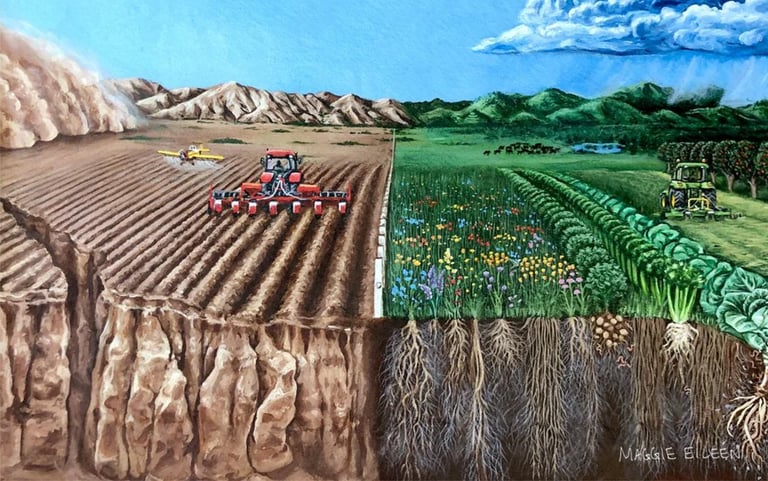From Soil to Sustainability: How Regenerative Agriculture, Composting, and a Circular Economy Can Combat Climate Change
The rise of conventional farming has contributed significantly to climate change through greenhouse gas emissions, soil degradation, and water pollution. To counter this, the solution lies in regenerative agriculture, composting, and fostering a circular economy. Regenerative practices, such as crop rotation, reduced tilling, and agroforestry, restore soil health, enhance biodiversity, and capture carbon. Composting diverts organic waste from landfills, reducing methane emissions and enriching soil, while a circular economy in agriculture repurposes waste and renews resources. Together, these practices offer a sustainable approach that can reduce environmental impact, regenerate ecosystems, and support resilient food systems.
11/14/20244 min read


The Rise of Conventional Farming and Its Role in Climate Change: Why the Answer Lies in Regenerative Agriculture, Composting, and Creating a Sustainable Circular Economy
Agriculture has always been a foundational aspect of human civilization. From small, community-focused farms to the sprawling, industrial-scale operations that dominate today, the evolution of farming has been driven by the need to feed a growing global population. However, the rise of conventional farming over the past century has come at a steep environmental cost, contributing significantly to climate change. The time has come to rethink our approach to agriculture, starting with a shift back to regenerative practices, composting waste, and fostering a circular economy.
The Environmental Toll of Conventional Farming
Conventional farming, or industrial agriculture, emphasizes maximizing crop yields through intensive use of synthetic fertilizers, pesticides, and monoculture planting. While this model has increased food production, it has also generated a series of environmental challenges with serious implications for climate change.
Greenhouse Gas Emissions: Conventional farming is a major contributor to greenhouse gases like carbon dioxide, methane, and nitrous oxide. Methane, for example, is produced by livestock digestion and manure management, while nitrous oxide is released from synthetic fertilizers. Both of these gases are far more potent than carbon dioxide, with methane having a warming potential 25 times higher over a 100-year period.
Soil Degradation: Industrial farming methods erode soil quality over time, depleting organic matter and beneficial microorganisms essential for crop health. Soil degradation also reduces soil's capacity to store carbon, which would otherwise be absorbed from the atmosphere and trapped underground.
Water Pollution: Excess fertilizers and pesticides run off fields and contaminate waterways, leading to nutrient pollution and dead zones in aquatic ecosystems. This contributes not only to the loss of biodiversity but also to emissions from the breakdown of these chemicals in water bodies.
Loss of Biodiversity: Monoculture farming—the practice of growing a single crop over large areas—destroys biodiversity by reducing the variety of plants, insects, and animals in the ecosystem. This approach also increases dependency on chemical inputs to combat pests and diseases, perpetuating a harmful cycle.
Why Regenerative Agriculture is the Answer
Unlike conventional farming, regenerative agriculture focuses on practices that restore soil health, increase biodiversity, and capture carbon from the atmosphere. This approach mimics natural ecosystems, improving resilience and sustainability. Some key regenerative practices include:
Cover Cropping: Growing cover crops in off-seasons prevents soil erosion, improves soil structure, and naturally replenishes nutrients without the need for synthetic fertilizers.
Crop Rotation and Polyculture: Rotating crops and planting diverse species in the same field increases biodiversity, reduces pest pressure, and enhances soil fertility.
Reduced or No-Till Farming: By minimizing tilling, farmers help retain soil structure and preserve microorganisms essential for nutrient cycling and carbon storage.
Agroforestry: Integrating trees and shrubs into farmland creates diverse habitats that support wildlife, sequester carbon, and reduce soil erosion.
Studies have shown that regenerative practices can significantly increase the amount of carbon stored in soil, effectively transforming farmland into a carbon sink. Regenerative agriculture also supports the production of nutrient-dense foods while reducing dependency on chemical inputs, making it an ideal solution to conventional farming’s climate impact.
Composting: Turning Waste into Wealth for the Soil
Every year, millions of tons of organic waste end up in landfills, where it decomposes anaerobically and produces methane. Composting offers a sustainable alternative by transforming organic waste into a valuable resource for soil health. By composting food scraps, yard trimmings, and agricultural waste, we not only reduce greenhouse gas emissions but also create nutrient-rich soil amendments that enhance plant growth.
Composting contributes to climate action in several ways:
Reduces Methane Emissions: Organic waste that decomposes in landfills produces methane, a potent greenhouse gas. Composting converts this waste aerobically, significantly reducing methane output.
Improves Soil Health: Compost enriches the soil with organic matter, improving its structure, water retention, and fertility. Healthier soils are better equipped to capture carbon and support plant growth.
Supports Sustainable Food Systems: By diverting organic waste from landfills and using it to enrich soil, composting promotes a sustainable cycle of nutrient recycling, connecting food production with waste management.
Moving Toward a Sustainable Circular Economy
A circular economy in agriculture means designing out waste, keeping materials in use, and regenerating natural systems. It’s an economy where waste becomes a resource, as in the case of compost, and where sustainable practices ensure that resources can be reused and renewed indefinitely.
In a circular agricultural system:
Waste is Minimized: Unused by-products from one process are repurposed for another. Organic waste, for example, is composted to improve soil rather than being discarded.
Resources are Renewed: Through regenerative practices, we can rebuild degraded soils, conserve water, and restore biodiversity, ensuring that natural resources are not only conserved but actively regenerated.
Resilience is Built-In: Circular systems are inherently more resilient, as they are not dependent on synthetic inputs and reduce reliance on external supply chains. This adaptability is essential in the face of climate change and unpredictable weather patterns.
The Role of Consumers and Policy
Shifting from conventional to regenerative agriculture, composting, and a circular economy will require collective effort. Consumers can support this change by choosing sustainably grown food, reducing their own waste through composting, and advocating for policies that promote regenerative practices. Governments can help by providing incentives for farmers to adopt regenerative methods and by investing in composting infrastructure to make it accessible to more communities.
In Conclusion
The rise of conventional farming has fueled climate change, but the solution lies in embracing regenerative practices, composting, and a circular economy. By returning to nature-inspired methods of agriculture, we can not only reduce our environmental impact but also create a healthier, more resilient food system. This transformation offers a way forward that nourishes the planet as well as future generations. As consumers, farmers, and policymakers work together, we have the power to turn our waste into wealth, regenerate our soils, and create an economy that truly sustains life on Earth.
